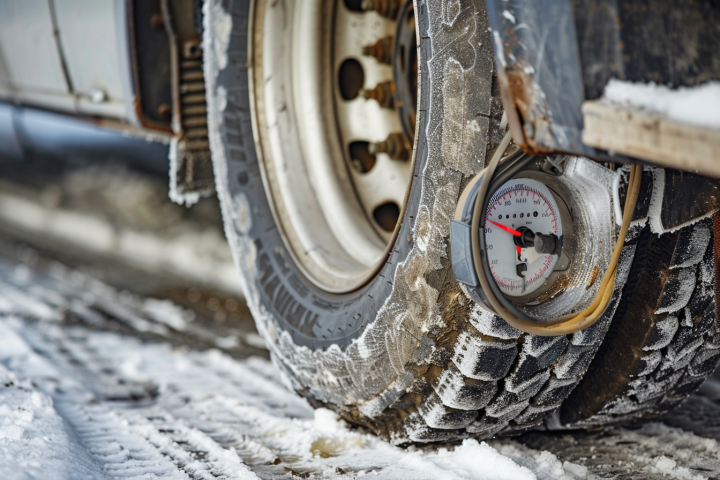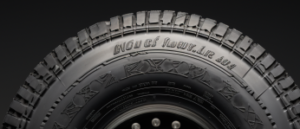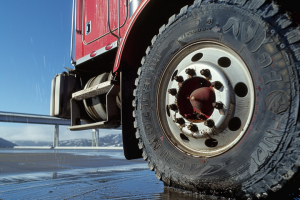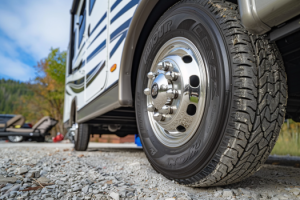Last Updated on April 22, 2024
Understanding Tire Pressure Monitoring Systems and Its Importance for Trucks
Tire Pressure Monitoring Systems (TPMS) are now essential to the safety of contemporary vehicles, particularly trucks. By offering real-time tire pressure information, TPMS contributes to increased road safety, fuel economy, and tire failure prevention. This section explores the fundamentals of TPMS technology and how important it is to vehicle upkeep and operation.
What are Tire Pressure Monitoring Systems?
The tire pressure monitoring system (TPMS) is an electronic device used in trucks and other vehicles to track the air pressure in pneumatic tires. These systems use a gauge, pictogram display, or straightforward low-pressure warning light to give the vehicle’s driver real-time tire pressure information. TPMS comes in two primary varieties:
- Direct TPMS sends information to the car’s computer system via pressure monitoring sensors within each tire.
- Indirect TPMS: It utilizes the car’s anti-lock braking systems (ABS) to compare rotational speed and deduce tire pressure.
Importance of Tire Pressure Monitoring Systems for Trucks
The significance of TPMS in trucks cannot be overstated:
- Tire Blowout Prevention: tire blowouts are a common cause of truck accidents, and TPMS helps prevent them by sending out early warnings regarding underinflated tires.
- Fuel Efficiency: Rolling resistance is decreased by adequately inflated tires, increasing fuel efficiency.
- Increased tire Life: Regular tire pressure checks guarantee that tires wear uniformly, which increases tire life.
- Enhanced Safety: Proper tire inflation is essential for the best possible braking and handling, particularly for large trucks.
- Cost Savings: Truck operators can save money by reducing tire-related mishaps and increasing fuel efficiency.

Scope of Our Review
Our review aims to provide truck owners and operators with a comprehensive understanding of TPMS technology and its benefits. We will cover:
- Different Types of TPMS: This section examines direct and indirect TPMS and which type suits other truck models.
- Key Features to Consider: Highlighting essential features such as accuracy, durability, and ease of installation.
- Regulatory Standards: Discuss the legal requirements regarding TPMS in trucks to ensure compliance and safety.
- Technological Advances: Exploring how technological advancements enhance TPMS functionality and user experience.
- Market Overview: Present a broad view of the current TPMS market tailored explicitly to trucks, including a range of products and their features.
What to Look for in Tire Pressure Monitoring Systems for Trucks
Several key factors must be considered when selecting a Tire Pressure Monitoring System (TPMS) for trucks. This system is a mere accessory and a crucial tool that can significantly influence a truck’s safety, efficiency, and operational costs. Here, we explore the essential aspects to look for in a TPMS specifically tailored for truck use.
Accuracy and Reliability
A quality TPMS should offer high accuracy in reading tire pressures and reliability in its performance, ensuring consistent and dependable monitoring for safe and efficient truck operation.
- Accuracy: A TPMS’s primary duty is to give accurate tire pressure readings. This precision is crucial for trucks because even a tiny variation in tire pressure can result in higher fuel usage and premature tire wear. To guarantee complete tire performance, look for a TPMS that provides accuracy within a few psi (pounds per square inch).
- Reliability: Long hauls in various situations are a standard part of trucking. A trustworthy TPMS should continuously provide accurate measurements without the need for frequent recalibrations or signal interruptions. Choosing a system with a reputation for consistent performance over time is crucial, particularly when driving in various situations.
Durability and Weather Resistance
Durability and weather resistance are essential for truck TPMSs, as the system must withstand varied and harsh driving conditions, including extreme temperatures, moisture, and road debris.
- Durability: Due to the demanding nature of transportation, a TPMS that can tolerate heavy use is necessary. This covers resilience to shock, vibration, and the rigors of extended-range travel. Robust sensors and parts that can withstand the rigors of truck driving are characteristics of long-lasting TPMS.id temperatures and intense heat. A high-quality TPMS must handle these varied circumstances without sacrificing accuracy. Seek systems that have a history of withstanding bad weather.
Compatibility with Different Truck Models
When selecting a TPMS, compatibility with different truck models is essential. It should be able to work with any truck, regardless of the brand or model, offering convenience and flexibility.
- Particular to Model Compatibility: Every truck type and configuration has a different tire configuration. You are selecting a TPMS appropriate for your truck’s specific model. Because of this interoperability, the system can reliably check the pressure in each tire according to the truck’s specifications.
- Sensor Configuration: While some vehicles are better suited for internal sensors, some require external sensors. Effective monitoring depends on whether the TPMS is compatible with the truck’s tire sensor arrangement.
- Particular to Model Compatibility: Every truck type and configuration has a different tire configuration. You are selecting a TPMS appropriate for your truck’s specific model. Because of this interoperability, the system can reliably check the pressure in each tire according to the truck’s specifications.
- Sensor Configuration: While some vehicles are better suited for internal sensors, some require external sensors. Effective monitoring depends on whether the TPMS is compatible with the truck’s tire sensor arrangement.

Ease of Installation and Use
The TPMS should be straightforward and user-friendly, with clear instructions and observant monitoring interfaces. This ease of use ensures that truck drivers and fleet managers can effectively use the system without extensive training.
- Installation: Setting up a TPMS ought to be simple. Systems that require the least amount of time and tools for installation are preferred, particularly for fleets when several trucks need to be equipped. Consider the availability and cost of professional installation services for complicated systems since they may be required.
- User-Friendly Interface: A TPMS’s daily operation depends on its ease of use. Drivers should not take long to comprehend and analyze the data that the system provides. Look for transparent displays, easy navigation, and an intuitive user interface.
- Integration with Existing Systems: If your truck is already equipped with other monitoring systems, finding a TPMS that can integrate seamlessly with these systems can be highly beneficial. This integration allows for more comprehensive monitoring and easier management of vehicle diagnostics.
When selecting a TPMS for trucks, it’s essential to consider the system’s accuracy, reliability, durability, weather resistance, compatibility with different truck models, and ease of installation and use. A well-chosen TPMS contributes to the safety and efficiency of truck operations and ensures compliance with safety standards and regulations. Truck owners and operators can invest in a system that meets their needs and enhances overall vehicle performance by focusing on these critical aspects.
Top Tire Pressure Monitoring Systems Picks for 2024
Selecting a tire Pressure Monitoring System (TPMS) is essential for safety and truck maintenance. As 2024 approaches, a few models emerge as standouts due to their outstanding features, dependability, and affordability. This article summarizes three prominent TPMS models, emphasizing their salient characteristics and feature-to-price comparisons.
TireMinder Smart Model TPMS-6
The TireMinder Smart Model TPMS-6 stands out for its advanced features and design. It offers truck owners a high-tech, reliable, user-friendly tire pressure monitoring solution.
- Superior Functionalities: The TireMinder Smart Model TPMS-6 is widely recognized for its state-of-the-art technology. Larger trucks or fleets will benefit significantly from its high accuracy real-time tire tracking and capacity to track up to 22 tires. In addition to temperature monitoring, leak detection, and quick pressure loss alarms, the system offers thorough tire health data.
- Robust Design: This concept is intended to tolerate the demands of trucking. Because of its strong design, its sensors can withstand harsh weather and uneven roadways. For professional truck operators, the sturdy design guarantees long-term dependability, making it an investment well worth it.
Tymate TPMS Model M7-3
The Tymate TPMS Model M7-3 offers a mixture of cost-effectiveness and user-friendliness, making it a proper choice for truck owners seeking a practical and affordable tire pressure monitoring solution.
- Cost-Effective: The Tymate TPMS Model M7-3 balances quality and affordability. It is a budget-friendly choice that keeps the essential features required for effective tire pressure monitoring.
- User-Friendly: This type is known for being user-friendly. Due to its user-friendly interface, truck drivers may easily install and use the system. Even people who are not tech-savvy can use it because of the clear alerts and transparent display.
TST 507 Tire Pressure Monitoring Systems:
For fleet managers and truckers who value precise and fast vehicle tire pressure information, the TST 507 TPMS is a top option because of its exceptional connectivity and real-time notifications.
- Superior Connectivity: Connection-wise, the TST 507 TPMS is a pioneer. Drivers may remotely check tire pressure using this device, which syncs with cellphones and other devices and gives wireless updates. Fleet managers would find this helpful function as they must monitor several trucks.
- Real-Time Alerts: This system reacts quickly, sending out alerts right away in the event of low pressure, high temperature, or rapid leakage. The real-time notifications improve road safety by enabling drivers to take immediate action to avert tire-related incidents.
Comparing Features and Pricing
When comparing these TPMS models, it is essential to consider both their features and pricing to determine the best fit for your truck or fleet:
- TireMinder Smart Model TPMS-6 suits those seeking advanced features and a robust design, regardless of its higher price point.
- Tymate TPMS Model M7-3 offers a balance of essential features at a lower price, making it an excellent choice for individual truck owners or small fleet operators.
- TST 507 TPMS stands out for its higher connectivity and real-time alerts, prioritizing immediate information and remote monitoring capabilities.
The choice of TPMS depends on individual needs and preferences. Whether it’s advanced features, budget considerations, or connectivity and real-time monitoring that are most important, a TPMS model in 2024 meets those specific requirements. Truck owners and operators can make an informed decision by considering the distinct features and pricing of these top TPMS picks.
Installation and Maintenance Tips
Proper installation and maintenance of a Tire Pressure Monitoring System (TPMS) ensures its effectiveness and longevity. This guide provides a step-by-step method for installing a TPMS in a truck, followed by essential maintenance and troubleshooting tips to keep the system functioning correctly.
Step-by-Step Installation Guide
Preparation: Before starting, ensure you have all the necessary components of the TPMS, including sensors, a display unit (if separate), and any required tools. Also, check the manufacturer’s instructions for any specific requirements.
Step 1: Mount the Display Unit:
- Select a spot for the display unit to allow the driver to view and reach it easily.
- Utilizing the included mounting gear, firmly fasten the display unit. Depending on the model, these could be adhesive strips or a bracket.
Step 2: Install the Sensors:
- Begin by deflating the tires slightly.
- Remove the valve caps from the tires.
- Attach the TPMS sensors to the valve stems of each tire. Ensure they are screwed on tightly to avoid leaks.
- Reinflate the tires to the recommended pressure.
Step 3: Program the TPMS: Place the display unit within the driver’s easy view and reach.
-
Secure the display unit using the mounting hardware provided. Depending on the model, this could be adhesive strips or a bracket.
- Turn on the display unit.
- Follow the manufacturer’s instructions to pair each sensor with the display unit. This usually involves entering the tire’s position (e.g., front left, rear right) into the system.
- Test the system by checking if the display unit correctly shows the pressure for each tire.
Step 4: Final Checks:
- Verify that all of the sensors are firmly affixed visually.
- Take a little drive and check the display unit to ensure all the sensors correctly transmit data.
Regular Maintenance and Troubleshooting
Any system’s long-term functioning and dependability, including those in the automobile sector, depend on routine maintenance and troubleshooting. This part covers the fundamental methods and procedures for keeping equipment operating at peak efficiency and handling typical problems when they emerge.
Regular Maintenance:
Trucks need regular maintenance, which includes checking the fluid levels, tire pressure, brake systems, and engine oil. Regular maintenance keeps the car in top operating shape and increases its operational lifespan by assisting in the early discovery of possible problems.
- Check Sensor Batteries: Most TPMS sensors are powered by batteries. Regularly check their charge and replace them as needed.
- Inspect Sensors: Periodically inspect the sensors for any signs of damage or wear. Look for cracks, loose parts, or corrosion.
- Keep Sensors Clean: Scratches and filth may affect sensors’ performance. Use a gentle, moist towel to clean them gently.
- Keep an eye on system alerts: After paying attention to any TPMS alarms or warnings, take the necessary action.
Troubleshooting Common Issues:
The first step in troubleshooting common truck problems is to identify symptoms, such as odd noises, changes in performance, or warning lights. For correct diagnosis and repair, effective troubleshooting frequently necessitates familiarity with the vehicle’s mechanics and consulting the manufacturer’s instructions or a qualified mechanic.
- No Signal from Sensor: If a sensor is not transmitting data, check its battery and ensure it is securely attached to the valve stem. If the problem continues, it may need to be replaced.
- Inaccurate Readings: Wrong pressure readings can be due to sensor calibration issues. Refer to the manufacturer’s instructions to recalibrate the sensors.
- Sensor Damage: If a sensor is visibly damaged, it should be replaced immediately to maintain system integrity.
Proper installation and diligent maintenance are critical to the effective functioning of a TPMS in trucks. By following these guidelines, truck operators can ensure their TPMS provides accurate tire pressure information, thereby enhancing safety and efficiency on the road. Regular checks and troubleshooting can prevent problems, ensuring the system remains reliable.
Benefits of Using Tire Pressure Monitoring Systems in Trucks
Since being implemented in trucks, Tire Pressure Monitoring Systems (TPMS) have significantly increased vehicle safety, operational effectiveness, and fleet managers’ and drivers’ general peace of mind. This article examines the several advantages of employing TPMS in vehicles.
Enhanced Safety on the Road
Maintaining vehicles regularly, following safety procedures, and utilizing cutting-edge technologies like TPMS contribute to increased road safety. These procedures guarantee truck drivers a safer driving environment and help reduce accidents.
- Tire Blowout Prevention: Reducing tire blowouts is one of the main safety advantages of TPMS. Tire pressure monitoring systems (TPMS) provide real-time tire pressure monitoring and warn drivers of severe under-inflation, significantly contributing to blowouts. It is essential to keep tires inflated to the recommended level, particularly in trucks and other large cars, where blowouts can cause serious collisions.
- Handling Vehicle Stabilization: tire pressure must be suitable for the best possible handling of the car. Under- or overinflated tires can cause possible road dangers by affecting the truck’s braking and cornering capabilities. Maintaining the proper tire pressure with the aid of TPMS ensures consistent handling qualities, which is particularly crucial in inclement weather.
- Early Detection of Tire Issues: Although a driver may not immediately notice a slow pressure reduction, TPMS systems can detect it. Early identification enables prompt maintenance, averting more severe issues.
Improved Fuel Efficiency and Tire Life
Maintaining proper tire pressure, ensuring balanced and aligned tires, and practicing good driving habits can improve fuel efficiency and extend tire life. These measures not only save costs but also contribute to environmental sustainability.
- Reducing Rolling Resistance: Because properly inflated tires reduce rolling resistance, moving the truck requires less energy from the engine (fuel). According to studies, fuel consumption rises by about 2% for every 10% of an underinflated tire. By assisting in the maintenance of ideal tire pressure, TPMS increases fuel efficiency.
- Increasing tire Life: Uneven tire wear is caused by under- or over-inflation. Tires with equal wear not only last longer but also perform better. Truck tire life can be significantly increased using TPMS, which lowers the frequency and expense of replacements by guaranteeing tires are always inflated to the proper pressure.
Real-Time Monitoring and Peace of Mind
Real-time monitoring systems, such as TPMS, provide drivers with quick feedback on the condition of their vehicles and foster peace of mind through continual awareness. By doing this, potential issues can be resolved quickly, preserving productivity and road safety.
- Instant cautions: The TPMS instantly warns drivers when a tire pressure discrepancy happens so they can take immediate corrective action. This real-time input is helpful for long-haul truck drivers who spend a lot of time on the road.
- Efficiency of Fleet Management: Fleet managers may combine TPMS systems with telematics to comprehensively understand each vehicle’s tire condition. This functionality allows for improved fleet management and better maintenance scheduling.
- Cutting Downtime: Tire-related problems are avoided with TPMS, lessening the chance of unplanned pauses and repairs and reducing truck downtime. The preservation of delivery schedules and operational effectiveness depends heavily on this dependability.

The Impact of Tire Pressure Monitoring Systems (TPMS) on Trucking
Truck tire pressure monitoring systems (TPMS) users’ firsthand knowledge of the advantages and difficulties of these devices is priceless. This article looks at a few case studies that show TPMS in operation, as well as the experiences and testimonies of professional truck drivers.
Feedback from Professional Truck Drivers
Professional truck drivers are the first to experience the daily benefits and occasional challenges of using TPMS. Their feedback is essential in understanding the system’s practicality, reliability, and overall impact on truck operation.
- Increased Safety: Many drivers feel more secure because their tire pressure is continuously tracked. The system’s ability to avoid accidents is demonstrated by the frequent mention of incidents in which TPMS warned users of possible tire failures before they became harmful.
- Operational Efficiency: When operating a large fleet or traveling long distances, drivers particularly appreciate the ease of manually monitoring tire pressure less frequently. This monitoring’s simplicity has increased on-road efficiency and downtime.
- Cost Savings: Long-term users of TPMS usually highlight the cost savings associated with reduced tire wear and improved fuel efficiency. Several drivers have shared experiences where TPMS helped extend tire life and reduce fuel consumption, leading to significant savings.
- Learning Curve: Some drivers mention a learning curve when understanding and examining the data and alarms supplied by the TPMS, even though many drivers value the technology. They eventually recognize the system’s value and simplicity after acclimating to it.
Case Studies: TPMS in Action
Case studies offer tangible examples of how TPMS systems benefit trucking ope1: Long-Haulse Study 1 significantly reduced dropped tire-related incidents and roadside repairs in a fleet specializing in long-haul deliveries. Because of the system’s real-time notifications, drivers can take care of tire problems before they reduce downtime and enhance safety records.
- Case Study 2: Regional Delivery Service: After installing TPMS on their trucks, a regional trucking company noticed a noticeable increase in fuel efficiency. Fuel consumption and operating expenses were decreased due to the continuous monitoring and maintenance of the ideal tire pressure.
- Case Study 3: Harsh Weather Conditions: A trucking company operating in areas with extreme weather conditions noted the durability and reliability of their TPMS. The system’s accurate readings and alerts in high and low temperatures gave drivers confidence in their tire conditions, regardless of the challenging environment.
The feedback from professional truck drivers and the insights from case studies emphasize the practical benefits of TPMS in the trucking industry. These real-world experiences show the system’s role in enhancing safety, improving operational efficiency, and offering cost savings while acknowledging the initial learning process. The continuous innovation of TPMS technology and increasing adoption in the trucking sector underscore its growing importance in ensuring safer and more efficient road transportation.
Conclusion and Recommendations
After carefully examining the options available in the truck tire pressure monitoring systems (TPMS) market, we’ve found a few exceptional ones that meet various demands and tastes. Every system has advantages, whether it be better connectivity, cost-effectiveness, or innovative features.
Summarizing the Top Picks
The TireMinder Smart Model TPMS-6 is an excellent option for people looking for solid design and advanced functions. It works incredibly effectively for bigger fleets when careful observation is necessary. The Tymate TPMS Model M7-3 is a great choice for individual truck owners or smaller fleet operators since it offers an excellent mix of quality and affordability. For individuals who value connectivity and real-time information, the TST 507 TPMS is a very dependable option. Long-haul truckers and fleet managers will find it very helpful.
Final Thoughts and Advice for Truck Owners
When selecting a TPMS, it’s crucial to consider the specific needs of your trucks. Assess factors like the size of your fleet, the average distances traveled, and the typical operating conditions. Investing in a high-quality TPMS can result in substantial long-term benefits, including reduced tire-related incidents, enhanced fuel efficiency, and extended tire life. Staying informed about the latest advancements in TPMS technology can also provide access to more sophisticated and user-friendly systems.
Regular maintenance of your TPMS is essential to ensure its effectiveness. This includes routine checks and timely replacement of sensors as needed. Additionally, ensuring that drivers and maintenance personnel are well-trained and familiar with your chosen TPMS is crucial for maximizing its benefits.
Obedience to local, state, and federal laws regarding TPMS in commercial vehicles is also essential. This helps avoid possible legal problems and ensures safety.
Why Choose Tires Easy Truck?
As we conclude our comprehensive guide on TPMS for trucks, it’s clear that the right choice of tire pressure monitoring systems goes hand in hand with the tires’ quality. At Tires Easy Truck, we understand the importance of high-quality tires in ensuring the safety and efficiency of your trucking operations.
We invite you to explore our extensive selection of premium tires designed to meet the diverse needs of truckers and fleet operators. With our range of top-tier tire options, you can find the perfect match to complement your new TPMS and enhance your truck’s overall performance and safety.
Explore Our Tire Collection at Tires Easy Truck
Whether you’re looking for tires that offer durability for long-haul journeys, superior traction for challenging terrains, or fuel efficiency for everyday operations, Tires Easy Truck has you covered. Please browse our selection today and take the first step towards a safer, more efficient, cost-effective trucking experience.
FAQs
What are the problems with Tire Pressure Monitoring Systems (TPMS) systems?
TPMS systems can experience wrong readings due to sensor malfunction, battery failure leading to signal loss, and damage or wear from harsh road conditions. Calibration issues can also arise, requiring regular check-ups and adjustments.
What is a Tire Pressure Monitoring Systems (TPMS) sensor on a truck?
A TPMS sensor on a truck is a device fitted inside or on the wheel that monitors the air pressure in each tire. It sends this data to the truck’s onboard computer system, alerting the driver to significant pressure variations.
What are some precautions when servicing a vehicle with Tire Pressure Monitoring Systems (TPMS)?
When servicing a vehicle with TPMS, it is essential to avoid damaging the sensors, ensure they are correctly reinstalled and recalibrated if necessary, and handle them carefully, especially during tire changes or rotations.
What Tire Pressure Monitoring Systems (TPMS) services must be performed?
TPMS services include sensor battery replacement, recalibration, repair or replacement of damaged sensors, and system diagnostics to look for errors or signal problems.
What is a tire pressure monitoring system (TPMS) for a truck?
TPMS on a truck is a system designed to continuously monitor the air pressure in the truck’s tires, providing real-time alerts to the driver if any tire falls below or exceeds the recommended pressure levels.
Do semi-trucks have Tire Pressure Monitoring Systems (TPMS) sensors?
Many modern semi-trucks have TPMS sensors as standard safety features, which help maintain proper tire pressure and prevent road-related incidents.
What are the two types of tire pressure monitoring systems (TPMS)?
The two types of TPMS systems are Direct TPMS, which uses physical sensors inside each tire to measure pressure, and Indirect TPMS, which calculates tire pressure based on wheel speed and other data from the vehicle’s antilock braking system (ABS).










